Stacking Silver and Gold Won't Fill A Hungry Belly So I Stack Seeds and Run a Micro-Farming Operation from a Countertop
I'm not knocking Gold and Silver Stacking, in fact, I think that's a great strategy and firmly believe in physical commodities that you can hold in your hands.
Sprouting seeds are one of those commodities and in my world, I think they are even more valuable than the highly sought after precious metals.
Here's a picture of part of my household's seed hoard:

You can see most of my seeds are coming from a company named Mumm's. They are located in Saskatchewan, Canada and all their seeds are organic. I also have organic seeds from A.Vogel's, from Germany and seeds from Veseys Seeds, located in Prince Edward Island, Canada.
Where ever you are getting your seeds, make sure they are for "sprouting" and I would highly recommend that you only buy organic, non-GMO. Most people who are interested in growing sprouts are also keenly interested in nutritional density. If you are making the time to grow sprouts, you want them to taste exceptional.
Sprouts grown from organic, non-GMO seeds, taste extraordinary.

If push comes to shove, the last thing you want to be doing is lining up to buy a can of soup at a grocery store with hundreds of other people, if the Supply Chain goes down or some type of disaster strikes.
I'm located in Canada and from my vantage point, it feels like the later is eminent for my friends to the south in the USA.
Sprouting can be done easily with nothing more than a wide mouth jar, 4 tbsp of sprouting seeds, water, a piece of fine weave cheese cloth or thin cotton fabric, an elastic band, and a fine mesh strainer.
Here's what to do:
- Put the 4 tbsp of seeds in a fine mesh strainer and rinse and drain them.
- Place the rinsed and drained seeds in a wide mouth jar.
- Cover the seeds with 2 cups of water and let the seeds soak for 12 hours.
- Place the cheese cloth or piece of cotton fabric over the mouth of the jar.
- Use the elastic band to hold the cloth or fabric in place over the mouth of the jar and make sure that the fabric creates a tight covering over the mouth of the jar.
- After the first 12 hours, drain the seeds by inverting the jar at an angle in a sink or large bowl.
- Rinse and drain your seeds twice a day. (You want the seeds to stay moist but not too wet.)
In about 3 days time, the jar will be filled with growing sprouts that you can eat. Once sprouted, the sprouts should be kept in the refrigerator. They will keep for a few days, but should be consumed as soon as possible to take advantage of all the amazing nutrients.
I never used the jar method but I did buy a small sprouter at my local health food store. It lets you rinse your trays of seeds and then the 3 sprouting trays, drain into a catch tray or reservoir at the bottom. The benefits of a wide mouth jar or a small sprouter is that they are relatively inexpensive and won't take up very much space in your kitchen. The draw-back is that you have to remember to water them regularly and they have to be drained really well or your sprouts will start to mold.
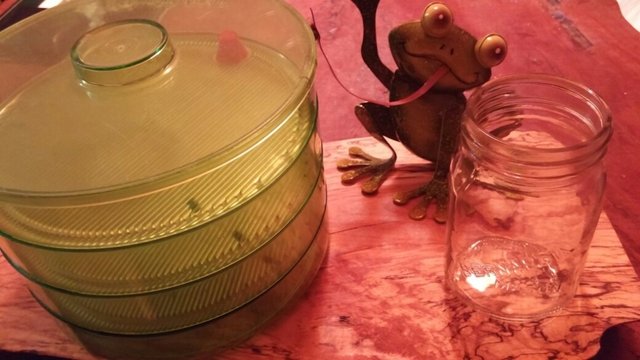
A few years ago, I upgraded my sprouting activities and invested in an apparatus which makes sprouting seeds virtually fool proof. It's called an "Easy Green Sprouter".
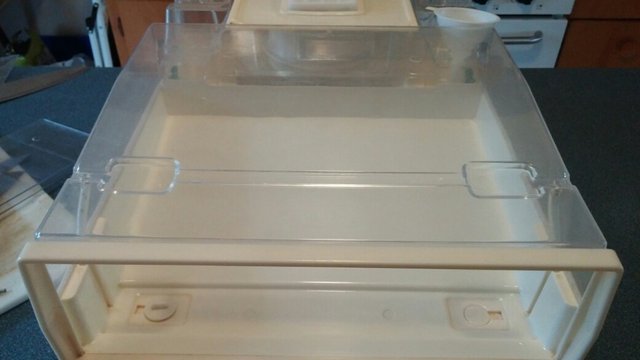
I just cleaned it today, so you can see the growing space. At the back is the water reservoir and a combination fan and mister which you plug into a timer so that you can set it to mist the seeds every 6 hours.
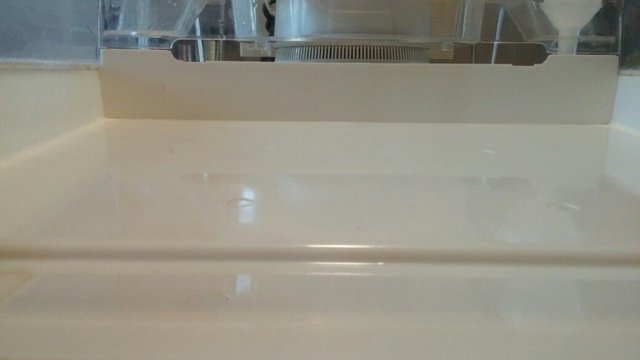
The growing space holds the seed trays. I try to only have a single layer of seeds in the bottom of each tray. I find that most of the seeds sprout if they aren't over-crowded. The Easy Green sprouter has drainage tubes or small hoses that drain the entire system very well. So, it needs to be placed somewhere near a sink or somewhere, where you can let the hose drain into a large pail.
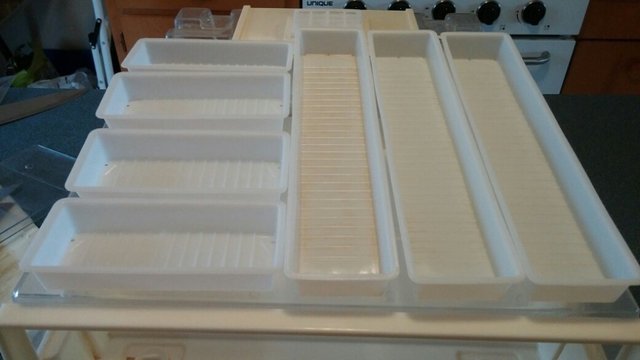
I have a selection of different sized trays. These units are made to stack so that you can sprout a large volume of sprouts at once. This would be important for large families or restaurants.
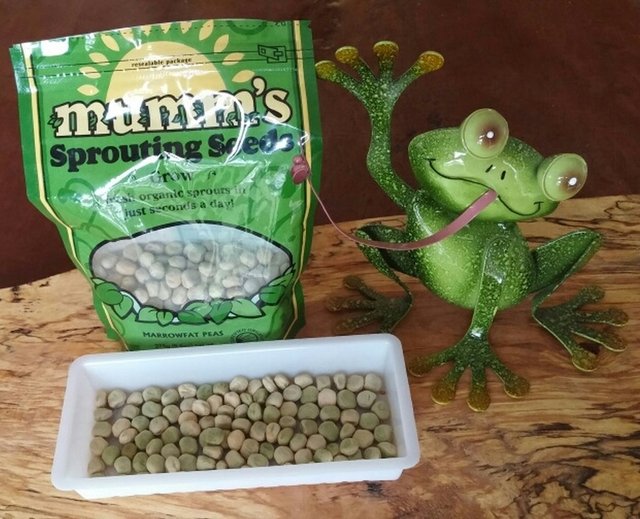
This is a tray of Marrowfat Peas that I am going to sprout.
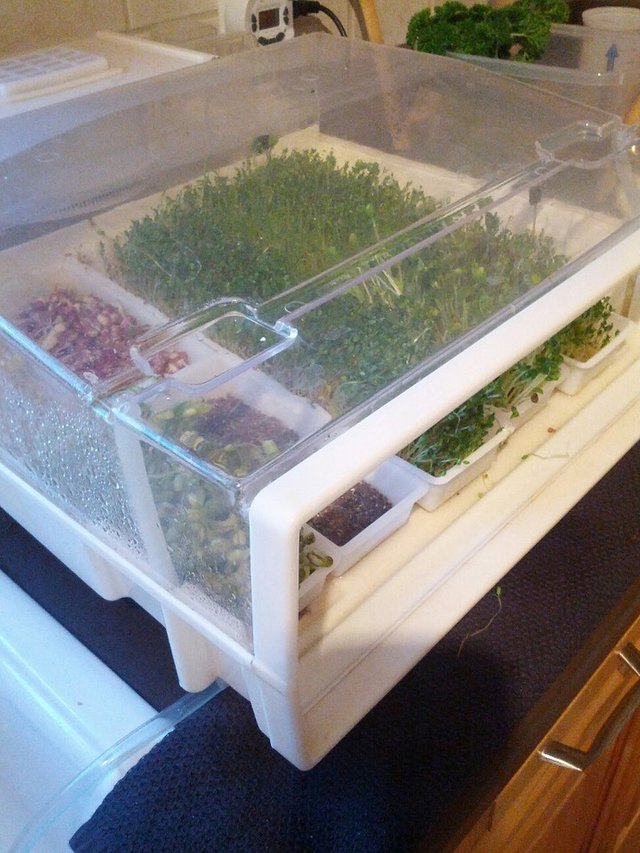
Here's my micro-farming kitchen garden in almost full production.
Here is a video showing each component of the Easy Green Sprouter. It was created by the Raw Nutrition Company. It was uploaded to YouTube on Nov. 8, 2013.
I generally try to keep lots of sprouting seeds on hand. Here's a list of the seeds I have, just to show the diversity of sprouts you can grow in your own kitchen:
- Spring Salad Mix (a blend of broccoli, radish, alfalfa, and clover);
- Crunchy Bean mix (a blend of peas, lentils and garbanzos);
- Broccoli;
- Marrowfat Peas;
- Garlic Chives;
- Red Clover;
- Alfalfa;
- Green Kale;
- Sunflower;
- and Mung Beans
The thing about seeds and sprouts is that they are incredibly nutrient dense because they have to contain all the key elements for the plant's survival. A broccoli sprout for example, contains 50 times the nutritional benefit of full grown broccoli. Just a handful of broccoli sprouts contain as much "sulphoraphone" as a pound of full grown broccoli and in the middle of winter, nothing can beat fresh sprouts, you have harvested with your own hands, from your own kitchen. It's a precious thing.
Physical silver and sprouting seeds are my preferred store of wealth.
I welcome your comments and invite you to follow along with me on my journey.
~RebeccaRyan
I sprout seeds from plants in my garden that have gone to seed, like radishes, broccoli, arugula, sunflowers, lettuce, peas, beans, and more. And I like #foraging wild seeds, too, and using those for sprouts, like amaranth, lambsquarter, and field mustard. Wonderful seeds are all around us. Thanks for your great directions about how to sprout!
Thank you for commenting @haphazard-hstead! I really appreciate it.
The seed thing is so crazy. I am positive that these "sprouting" seeds that I am buying would grow into fully mature plants if I planted them in soil. It says right on the packages "Seeds for human consumption (sprouting) Not for propagation." That sounds like BS to me and I think it's a work around to let the companies sell their seeds at a different price point. Much lower than what you would expect. I bought a 100 gram bag of sprouting organic non-gmo broccoli seeds for under $2.50. It probably would have cost me upwards of $50 or more to buy the same quality of broccoli seed in stardard "meant for your garden variety packaging. Like so many things on this planet, the game is rigged.
Yeah, it would be interesting to see the business side of the broccoli seed for growing the plants vs. broccoli seeds for sprouting. From my own gardening experience, it would be a lot easier (and thus cheaper) to grow for sprouting seeds. I don't have to worry about cross-contamination of the seed by some other genetics, or genetic drift back to a more primitive form of broccoli. And so many gardeners will buy hybrid seed for growing broccoli heads. So that takes a lot more effort. Someone has to keep growing the parents of the mother and the father, each staying pure in their genetics, and then they have to let the mother and father broccoli grow together to create the hybrid. But I can take the seed from any hybrid broccoli that has been in my garden too long, and still use its seed for sprouting.
There are folks that take hybrid crops and still save the seeds to grow out. While they plants won't be true to type and exactly like their parents, they will still have good underlying genetics. So some will be great, too, and if you save those seeds, and keep saving them every year, you can get a nice strain that really suits your local conditions. Frank Morton is a big fan of this approach and has a lot of "wild" mixes. Anyway, that was a long ramble! Enjoy your sprouts! :D
Thanks for this information! In my opinion, organic and heirloom seeds are worth more than gold. There are places, kind of like seed libraries that archive and allow seed swapping among members. I am hopeful that these initiatives won't be illegal in the future.
It is key to allow us to protect our food sovereignty. It is how we can defend the rights and ultimately the survival of future generations of beings (humans and animals) of earth.
It's a deep thought...but I think all beings have the right to nutritionally dense food, produced in the areas where they live, appropriate to their cultures. Basically, saving viable, non-gmo seeds equates to survival of everything living on our planet. :)
In some cases, it might not actually be rigged. Sometimes due to plant life cycles and breeding, the seeds of a plant lead to something pretty weird compared to the original plant. Looks like @haphazard-hstead mentioned the hybrid thing down below. I know it's true for many apple varieties, because the roots of most apple trees are a different variety than the branches (which have been spliced in). In my understanding, the seed of most apples would grow a tree that is more like the parent's roots than the parents branches.
Anyway, nice post!
Thanks for commenting @biophil and providing information to add to this discussion.
I think the whole grafting of fruit trees is interesting. My Mother-in-law is really skilled at starting fruit trees from seeds. So, often when we find a very old wild apple tree, that is still producing, she'll taste the fruit and pick seeds from the fallen fruit. She's probably started 30 trees that way and she just gives them away. :)
Cool! How are the arugula sprouts? I let my arugula beds get out of hand this summer and now I have more seed than I know what to do with. I had thought about sprouting them, but I figured they'd be so small that it wouldn't be worth it.
You know what to do with all those seeds, haha! :D They have great flavor, right from the start. They like it cool and grow fast.
What a cool post! Your instructions and pics are great. I sprout microgreens during the winter months and they're so good. Keep up the good work and Steem on.
Thank you so much @luzcypher!
I really appreciate your encouragement.
I wasn't sure if others would be interested in sprouting or not and I'm glad to learn that there are. :)
Most definitely. There's a large community around food here and the gardening and growing community are, well, growing. I'm glad you're a part of it. Have you seen @gardenofeden? I love what they're doing to build community.
I have read some comments from @gardenofeden and I think it's incredible that they are providing food for so many people. I am following them.
Fantastic post. Keep these coming. At some point steem will go up and efforts like these will be more fulfilling, I hope. We used to have a lot of heirloom seeds, but then we moved to Chile where they do not allow import of seeds. Your ideas are spot on. STEEM ON!
Thank you and thanks for your comment, too @gringalicious. Wow! I didn't know that you can't import seeds into Chile. Can you still buy seeds within the country? Does Chile's climate, where you are located, allow you to grow year round if you want to?
That is a sweet little food machine you have there! It does look like a great idea for the winter months. So, which ones are the tastiest?
Thanks for commenting @tinfoilfedora!
Garlic Chives
Sunflower seeds
and Broccoli
are my favourites and in that order too!
Garlic chives do sound good, I will have to try those first.
Thanks for all the info.
It was my pleasure. You're welcome. :)
Upvoted by gardening-trail
Join us in the steemtrail chat channelThank you for being part of the gardening community on Steemit.
Thank-you. I really appreciate it.
Thanks for the info on sprouting your own seeds. I've always wanted to try and do it.
Thanks for your comment @cavemanrob! I hope you do try it. Just know that your seeds need to stay moist, but not too moist or you'll grow mould. That's why I upgraded to the big system that makes the process super easy and almost "fool-proof".